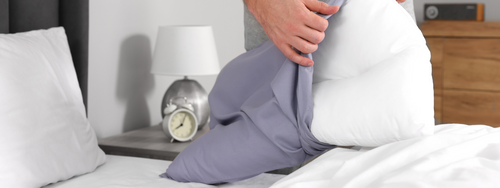Share:
In our quest for better skin health, we often overlook a critical element of our daily routine—what we sleep on. For those with sensitive skin or particular skin health concerns, the choice of pillowcase isn't merely about aesthetics or comfort; it involves understanding the interaction between fabric and skin over the long, uninterrupted hours of the night. This article delves into how different pillowcase materials can impact your skin and why technologies like copper-infusion could be transformative for your nightly skincare regimen.
Understanding Different Fabrics
Pillowcases, often made from a variety of materials including cotton, silk, and synthetic fibers, each interact with our skin in unique ways. Cotton, popular for its breathability and ease of care, unfortunately tends to absorb moisture from the skin and hair. This can lead to dryness, especially problematic for those with dry or sensitive skin types. Silk, on the other hand, is smoother and less absorbent, which helps in reducing skin friction and moisture loss, making it a preferred choice for beauty-conscious individuals. Synthetic fibers, while durable and resistant to wrinkling, often trap heat and can aggravate skin irritation, particularly in warmer climates.
However, beyond just the type of material, the construction of the fabric—its weave and thread count—also plays a pivotal role in its effects on skin health. A finer weave and higher thread count enhance the smoothness and softness of a fabric, qualities that are beneficial in minimizing friction and irritation.
Spotlight on Copper-Infused Fabrics
Emerging as a frontrunner in the innovation of functional textiles, copper-infused fabrics bring a new dimension to the traditional pillowcase. Copper, a natural mineral with profound intrinsic properties, offers multiple benefits for skin health:
- Collagen Production: Copper plays a crucial role in synthesizing collagen, a protein foundational to skin elasticity and firmness. Pillowcases infused with copper can, over time, help in maintaining skin’s youthfulness and reducing the appearance of fine lines and wrinkles.
- Antioxidant Defense: The skin is constantly exposed to free radicals, which can lead to premature aging and cellular damage. Copper acts as a cofactor for enzymes like superoxide dismutase, which are vital in defending against oxidative stress.
- Wound Healing: Copper is known to enhance the healing of small wounds and abrasions by supporting angiogenesis—the formation of new blood vessels—and new collagen production. This property is especially beneficial for those with acne-prone skin, as it can help expedite the healing of acne scars.
- Antimicrobial Properties: Copper’s ability to destroy pathogenic microorganisms is well-documented. It possesses a broad-spectrum antibacterial, antiviral, and antifungal activity, which is essential in a pillowcase where the buildup of microbes can exacerbate skin conditions.
The antimicrobial action of copper is multifaceted. It can rupture bacterial cell membranes, inhibit the replication of viruses, and prevent the growth of fungi. This triple action makes copper-infused pillowcases a potent ally in maintaining skin cleanliness and health.
Scientific Backing
Several studies corroborate the benefits of copper-infused textiles. Research indicates that copper-infused fabrics reduce microbial contamination significantly, which is particularly beneficial for those suffering from acne or dermatitis, as these conditions can be aggravated by bacterial and fungal pathogens. Furthermore, copper’s involvement in collagen synthesis and wound healing has been supported by clinical studies showing improved skin elasticity and texture with long-term use of copper-infused materials.
Comparative Analysis
When comparing traditional pillowcase materials with copper-infused options, the latter clearly offers additional skin health benefits. While silk and high-thread-count cotton might provide softness and reduced friction, they do not actively contribute to skin health beyond passive benefits. Copper-infused pillowcases not only minimize friction but also actively participate in the skin’s natural renewal processes and protect against pathogens.
Conclusion
Choosing the right pillowcase is a significant yet often overlooked aspect of skin care. As we understand more about the materials our skin interacts with nightly, the benefits of choosing fabrics that support our skin health goals become clear. Copper-infused pillowcases embody a perfect blend of science and comfort, offering a proactive approach to maintaining skin health. Their unique properties not only enhance the quality of our sleep but also our overall skin health, making them a worthy investment for anyone serious about skincare.
References
- National Institute of Health: "Copper and Your Health"
- Journal of Applied Microbiology: "Antimicrobial properties of copper"
- International Wound Journal: "The role of copper in wound healing"
- Dermatologic Therapy: "Copper Oxide Impregnated Textiles for the Management of Skin Conditions"
- Cosmetic Dermatology: "The Role of Metals in Cosmetics: Focus on Copper"



